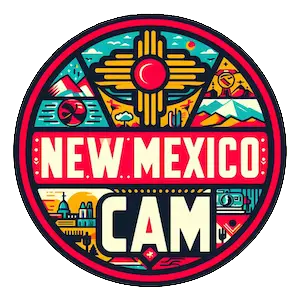Zuzax, NM Weather Cams
Zuzax, NM I-40 Cam
Zuzax: The Tiny New Mexico Town That Almost Wasn’t
Espanola, NM Weather Cams. Nestled in the eastern foothills of the Sandia Mountains, about 20 miles east of Albuquerque, lies the small unincorporated community of Zuzax, New Mexico. With a population of less than 100 residents, Zuzax is a blink-and-you’ll-miss-it kind of place. Yet, this tiny settlement has a rich history that spans over a century, marked by resilience, adaptation, and the enduring spirit of its inhabitants.
The story of Zuzax begins in the late 19th century when the area was primarily inhabited by Native American tribes, particularly the Pueblo people. The rugged terrain and sparse vegetation made it an unlikely spot for permanent settlement, but its strategic location along what would become a major transportation route would soon change its fate.
In the early 1900s, as the railroad industry expanded westward, surveyors identified the area now known as Zuzax as a potential site for a rail stop. The Atchison, Topeka and Santa Fe Railway (AT&SF) was pushing its tracks through the Tijeras Canyon, connecting Albuquerque to points east. In 1908, a small station was established at the site, initially known as “Carnuel Station” after the nearby Carnuel land grant.
The origin of the name “Zuzax” is shrouded in mystery and local lore. One popular theory suggests it was named after a Native American chief, while another claims it was derived from a Spanish phrase. However, the most widely accepted explanation is that it was simply an arbitrary name chosen by railroad officials, as was common practice for many small stations along the line.
As the railroad brought increased traffic and commerce to the area, a small community began to form around the Zuzax station. By the 1920s, a handful of families had settled in the vicinity, establishing homesteads and small farms. The harsh desert climate and limited water resources made agriculture challenging, but the residents persevered, growing crops like pinto beans, corn, and chilies.
The Great Depression of the 1930s hit Zuzax hard, as it did many rural communities across America. Some families were forced to abandon their homes and seek opportunities elsewhere. However, a core group of resilient settlers remained, adapting to the changing economic landscape by taking on jobs with the railroad or finding work in nearby Albuquerque.
World War II brought a brief period of increased activity to Zuzax. The railroad station saw heightened use as troops and supplies were transported across the country. Some local men enlisted in the armed forces, while others found employment in war-related industries in Albuquerque.
In the post-war years, Zuzax faced a crossroads. The rise of automobile travel and the development of the interstate highway system threatened to render the small railroad stop obsolete. By the 1950s, passenger service to Zuzax had been discontinued, and the station was used primarily for freight operations.
However, the construction of Interstate 40 in the 1960s, which closely paralleled the railroad tracks through Tijeras Canyon, breathed new life into the community. While the highway didn’t directly pass through Zuzax, it brought increased visibility and accessibility to the area. Some entrepreneurial residents opened small businesses catering to travelers, including a gas station and a modest diner.
The 1970s and 1980s saw a gradual shift in Zuzax’s character. As Albuquerque’s eastern suburbs expanded, some city dwellers began to look to the foothills for a more rural lifestyle. A few newcomers purchased land in and around Zuzax, building homes that blended with the natural landscape. This influx, while small, helped to stabilize the community’s population and brought new ideas and energy to the area.
In the late 20th and early 21st centuries, Zuzax has maintained its status as a quiet, close-knit community. The railroad, while no longer the lifeblood of the town, continues to run through it, serving as a reminder of its origins. The area’s natural beauty, including its proximity to the Cibola National Forest, has attracted outdoor enthusiasts and those seeking a connection to nature.
Today, Zuzax faces both challenges and opportunities. The limited infrastructure and services in the area can make daily life challenging for residents. Water scarcity remains an ongoing concern, as it has been throughout the community’s history. However, the growing interest in rural living and telecommuting has made Zuzax an attractive option for some who wish to escape the bustle of city life while remaining within commuting distance of Albuquerque.
The community has also embraced its unique history and character. In recent years, local efforts have been made to document and preserve Zuzax’s heritage. A small museum housed in a converted railroad car showcases artifacts and photographs from the town’s past, serving as a point of pride for longtime residents and a source of fascination for visitors.
Looking to the future, Zuzax stands at another crossroads. As climate change impacts the American Southwest, the community will need to adapt to increasingly arid conditions and the threat of wildfires. There are also ongoing discussions about potential development in the area, with some residents advocating for growth and others preferring to maintain Zuzax’s small-town character.
Despite these challenges, the spirit that has sustained Zuzax for over a century remains strong. The community continues to embody the resilience and adaptability that have defined it since its inception. From a lonely railroad stop to a tight-knit rural enclave, Zuzax has proven that even the smallest dots on the map can have a story worth telling.
As travelers speed past on I-40 or catch a glimpse of the settlement from a passing train, few may realize the rich history contained within this tiny New Mexico town. But for those who call Zuzax home, it remains a place of enduring significance—a testament to the power of community and the allure of carving out a life in the shadow of the Sandia Mountains.
For more information, visit the Zuzax, New Mexico official website.
